with Willy Ivins
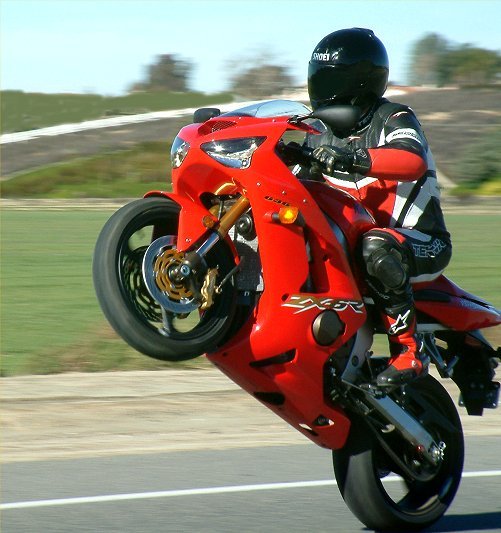
MD has already brought coverage of the world race track intro of the Kawasaki ZX-6R from Malaysia, as well as a preview article outlining some of the technical highlights of the new, 636cc sportbike from Kawasaki. Just yesterday, Willy and I had a chance to ride this machine here in the United States for the first time (you may recall that MD’s race track session in Nevada was cancelled a couple of weeks ago due to rain). We share bi-line credit on this article, despite the fact that I am writing it, because Willy and I have shared seat time on the 6R thus far, and this article reflects the impressions of each of us.
Starting a report such as this one with a worn out cliche violates every rule about good writing, but here goes. There is no substitute for displacement . . . at least, when it comes to engine performance. The 37cc displacement advantage (6.2%) Kawasaki wields over its “competitors” in the “600 class” is put to very good use in the 2003 6R.
On paper, you would expect the thoroughly modern engine design offered by Kawasaki (including fuel injection and an extremely high, stock compression ratio of 12.8 to 1) in such a light package (a claimed 355 pounds dry — and it feels this light!) to be a ripper. It is.
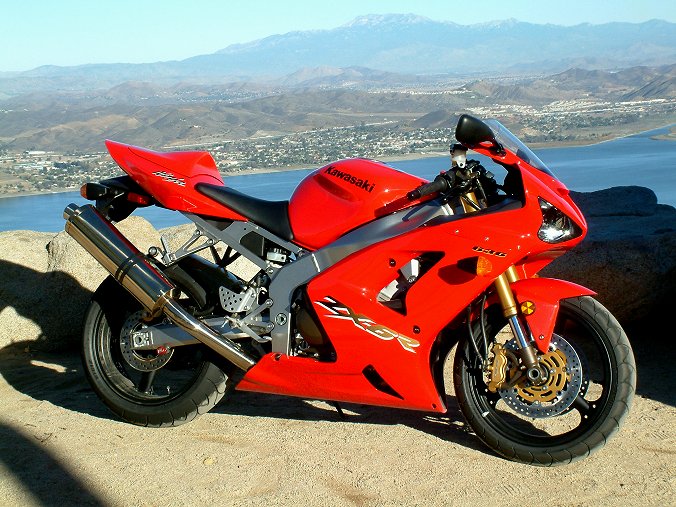
After one session through a particularly tight, twisty road that Willy and I are familiar with, Willy commented that the 6R (exiting a corner at 10,000 rpm in second gear) smoothly power-wheelied from corner exit to the next corner entry, where it dropped its nose and smoothly turned into the next corner without even a hint of head shake. Sweet!
Indeed, although the Kawasaki ZX-6R does many things very well, it is the engine performance that stands out after our first ride. The dual butterfly fuel injection design (with one butterfly mimicking the effects of a CV carb) works flawlessly. Throttle transitions (completely closed throttle to open throttle, even while leaned over) are without any surging, whatsoever. It is the amount and spread of power that just about knocks you out, however, not its smooth delivery.
Some of the journalists in attendance at the Malaysian race track intro last month commented that the 6R lacks mid-range. We suspected this was not, in fact, the case, instead being a misperception brought on by the huge top-end rush the 6R provides. We were right . . . the 6R has pretty darn good mid-range.
To test mid-range roll-on, we brought along a very healthy 2002 Honda CBR600F4i. This F4i is the beneficiary of a Yoshimura slip-on system, as well as the sophisticated EMS on-board computer system (not to mention several hours of dyno time at the Yosh headquarters) we wrote about on May 16, 2002. We are pretty confident that this particular F4i would walk away from virtually any stock 600 in the mid-range. If you drop the revs low enough, it will also walk away from the 2003 ZX-6R, but at about 7,000 rpm (which is rightly labeled “mid-range” on a bike that redlines at 15,500 rpm, as the ZX-6R does) the 6R easily pulls away from the F4i. On top, the 6R engine performance is simply phenomenal.
The 6R pulls hard from 8,000 rpm, very hard from 9,500 rpm, and extremely hard from 11,000 rpm all the way to 15,000 rpm. Despite feeling like it has a fair amount of weight over the front wheel (and the inherent stability discussed earlier), the 6R will power wheelie in first gear if you wack the throttle at 11,000 rpm — even if you have your weight right over the tank and bars. Most 600s require a tug on the bars, and a weight shift to boot. The 6R will wheelie whether you want it to or not, so be ready!
The front wheel will also catch some air in second gear in this same rpm range (11,000 – 15,000 rpm) without touching the clutch. Knowing that our Yoshified F4i is nudging 100 horsepower at the wheel (now that it is broken in), we would estimate the new 6R has a firm grasp on at least 105 wheel horsepower stock. Not a bad peak horsepower output for the displacement, and pretty remarkable, really, given the 7,000 rpm spread of thrust between 8,000 and 15,000 rpm.
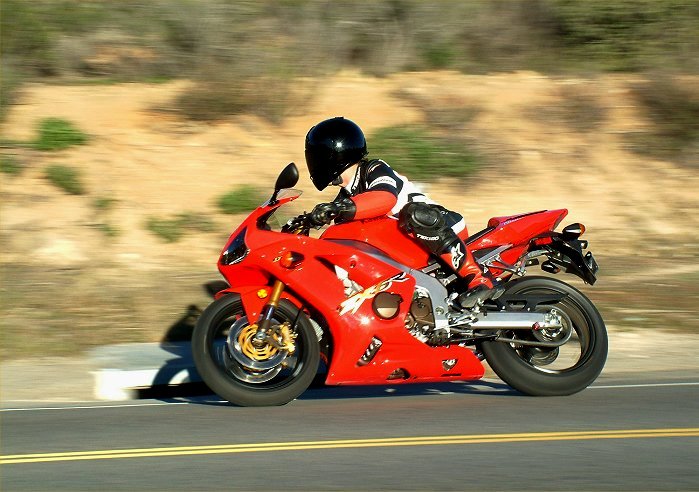
Okay, so this is probably enough talk about the engine performance of the 2003 ZX-6R, but there is one other item worth mentioning. Kawasaki has significantly increased tuning potential of the 6R by providing slotted cam sprockets on the stock machine (yes, that means adjustable cam timing). This is unique on a stock supersport machine (in addition to the other unique features discussed in our preview article dated September 16, 2002).
The chassis of the ZX-6R is impressive, as well. The bike has a very solid, stable feel to it. At the same time, steering feels light (due, at least in part, to the small, 280mm brake discs, which reduce gyroscopic effect on the front end). The bike is never twitchy, changing directions confidently, but with poise.
Although we experienced good feedback from the chassis and the tires, this will undoubtedly be improved further by suspension adjustment. Our limited time on the bike didn’t allow detailed tuning adjustments. The fully-adjustable fork and shock (including rear ride-height adjustment) on our own unit came with settings presumably from the intro at Sepang, and worked quite well out-of-the-box.
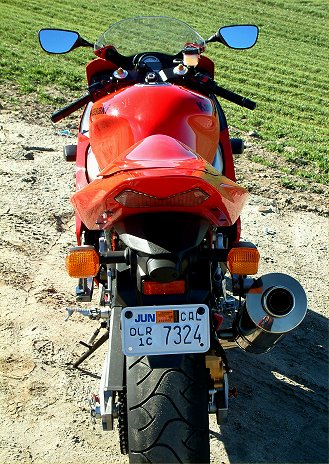
Although we might have expected a harsh feeling from the upside-down fork, it was really quite plush. Kawasaki seems to have mated this rigid fork design with chassis rigidity quite well.
Engine vibration is quite low and vibration through the pegs is virtually non-existent. You know the engine is working underneath you, but those sensations (as well as feedback from the road) never disturb your comfort. The ergonomics of the new 6R are clearly more aggressive than last year’s bike. This is by design, of course, and reflects an increasingly more aggressive “race-replica” approach to the middleweight sportbike class by other manufacturers. The riding triangle (seat/bar/peg relationship) works reasonably well, however, and really compliments the aggressive performance potential the bike offers. More weight over the front end, with the rider position closer to the steering head, increases confidence during aggressive cornering. The trade-off is reduced comfort, and increased weight on the wrists at sub-60 mph speeds, while cruising in a straight line.
Wind protection from the fairing was surprisingly good, despite its small frontal area. There is something about the shape of the 6R’s front end that throws the wind fairly high onto the rider’s chest and shoulders, but keeps buffeting at helmet level to a minimum.
Those radial brakes everyone is talking about are quite good. Initial bite was noticeably stronger than our companion 600, although overall power appeared to fall somewhat short of our exalted expectations. This could relate to the fact that our test unit was flown in from the Malaysian race track intro — where the front brake pads could have received a glazing. A ride on a new, production unit at a later date should clear this up.
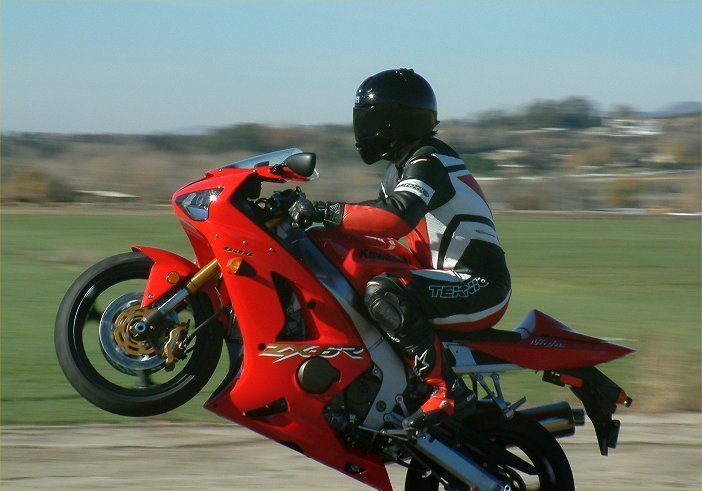
The new instrument panel (pictured in our preview article) works well, with one exception. Riding in bright sunlight, it is somewhat difficult to read the tachometer, which is an LED bar graph that sweeps around the outside of the instrument cluster. The black bar simply doesn’t contrast enough with the grey background.
So, our first impression of the 2003 Kawasaki ZX-6R is certainly a favorable one. The new engine, in particular, is stellar. Despite the extra engine displacement, and the performance that comes with it, Kawasaki has priced the ZX-6R at $7,999, just $100 more than last year’s 599cc model. The 6R should be available in U.S. dealerships in a month or so.





